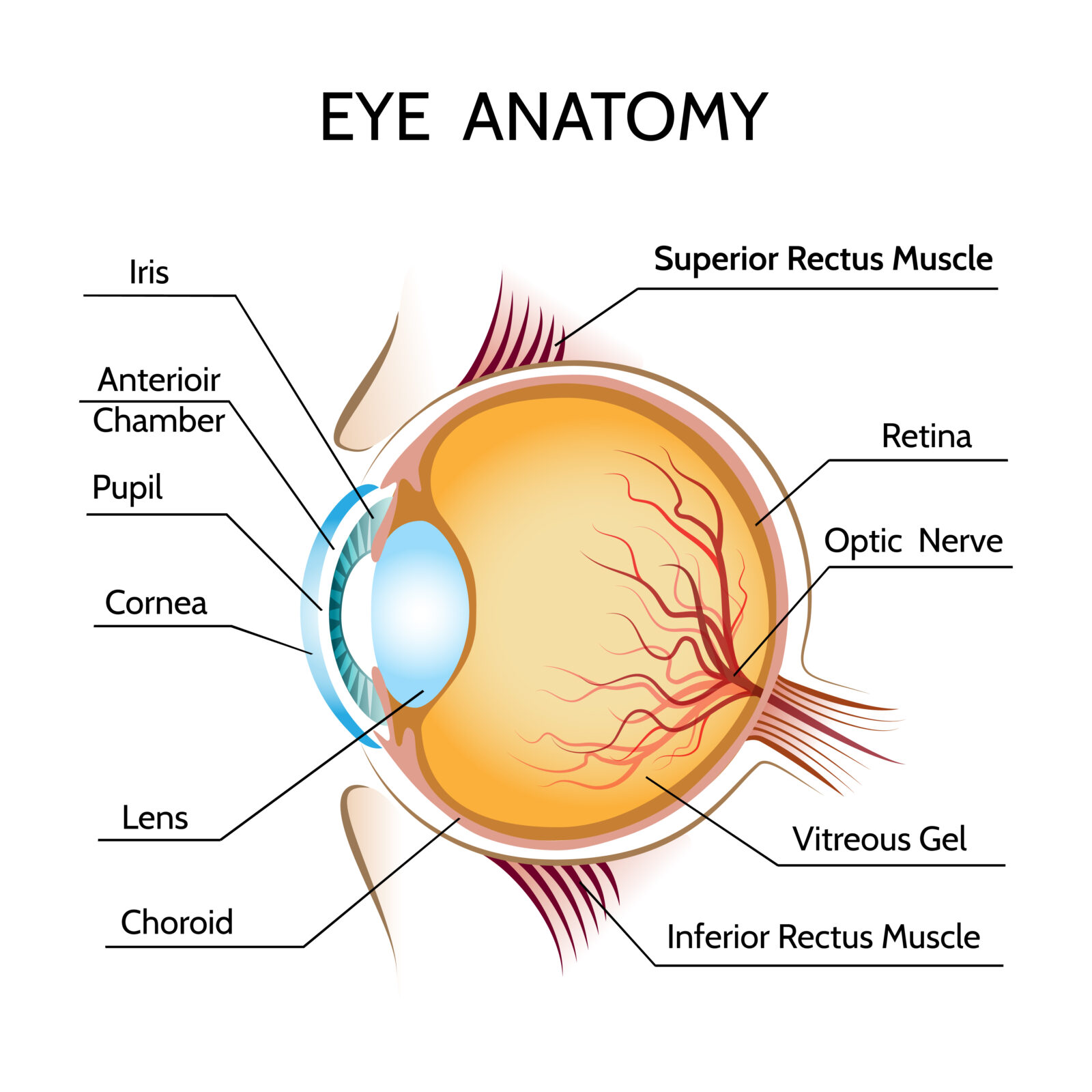What is Myopia?
Myopia, also known as nearsightedness, is a common refractive error where distant objects appear blurry, while nearby objects remain clear. This condition occurs when the eye’s shape causes light to focus in front of the retina, the light-sensitive tissue at the back of the eye, rather than directly on it. As a result, those with myopia often experience difficulties seeing things clearly at a distance, such as road signs or classroom boards, while reading a book or using a smartphone may not pose a problem.
Myopia can vary in severity and is classified into mild, moderate, and high levels based on how much correction is needed to restore clear distance vision. People with severe myopia (high myopia) have a greater risk of developing other serious eye conditions, making regular eye exams essential for early diagnosis and management.
The Anatomy of Myopia
To understand myopia better, it’s important to examine the eye’s structure:
- Cornea: The clear, dome-shaped front surface of the eye
- Lens: The transparent structure behind the iris that helps focus light
- Retina: The light-sensitive tissue at the back of the eye
In a myopic eye, either the eyeball is too long, or the cornea’s curvature is too steep. These structural variations cause light rays to converge in front of the retina rather than precisely on its surface, resulting in blurred distance vision.
Symptoms of Myopia
The most common symptoms of myopia include:
- Difficulty seeing distant objects clearly, such as signs or TV screens
- Squinting to improve focus
- Eye strain, which may manifest as tired or sore eyes
- Headaches caused by overworking the eyes
For those with mild myopia, the symptoms might not be noticeable, but regular eye examinations can help identify any vision issues early. High myopia can lead to more severe complications, underscoring the importance of consistent monitoring and treatment.
Risk Factors and Causes of Myopia
Genetic Factors
Genetics play a significant role in the development of myopia. If one or both parents are nearsighted, the likelihood of their children developing the condition increases. This hereditary link suggests that eye shape and refractive characteristics can be passed down through generations.
Environmental Influences
Lifestyle and environmental factors are also influential in the development of myopia. Children who spend extended periods on close-up activities, such as reading, computer use, or playing on smartphones, may have a higher risk of becoming nearsighted. Conversely, outdoor activities and exposure to natural light have been linked to a lower incidence of myopia, although the exact reasons are still being studied.
Eye Structure
Myopia arises when the eyeball is elongated from front to back, or when the cornea (the clear front part of the eye) has a steeper curve than normal. These structural differences cause light to focus in front of the retina, leading to blurry distance vision. Variations in corneal or lens shape can also contribute to the condition.
How is Myopia Diagnosed?
An eye care professional can diagnose myopia through a comprehensive eye exam. This evaluation typically involves checking the clarity of your distance vision using a series of lenses and other tests. The process is straightforward, painless, and critical for determining the appropriate corrective measures needed to achieve clear vision. The process typically includes:
- Visual acuity test: Measures how well you can see at various distances
- Refraction assessment: Determines the exact lens power needed to correct your vision
- Eye health evaluation: Examines the overall health of your eyes
Advanced diagnostic tools, such as Wavefront analysis and corneal topography, may be used to provide a more detailed assessment of your eye’s refractive errors.
Treatment Options for Myopia
There are several effective treatment options available for managing myopia, ranging from non-invasive solutions to surgical interventions. Each option aims to improve how light is focused on the retina, thereby enhancing distance vision.
Corrective Lenses
- Eyeglasses: Eyeglasses are the most straightforward and non-invasive treatment for myopia. They correct the refraction by using lenses that diverge light, ensuring that it focuses directly on the retina. Eyeglasses are safe, versatile, and can be customized to suit individual needs.
- Contact lenses: Contact lenses offer an alternative to eyeglasses for those who prefer not to wear frames. They sit directly on the eye’s surface, providing a wider field of view without the interference of frames. Contact lenses come in various types, including daily wear, extended wear, and specialized lenses for different refractive needs. However, proper hygiene is essential to prevent complications such as infections.
Refractive Surgery: LASIK and PRK
For adults seeking a long-term solution to myopia, refractive surgery is an option worth considering. LASIK (Laser-Assisted In Situ Keratomileusis) and PRK (Photorefractive Keratectomy) are two of the most common procedures.
Why LASIK is a Preferred Solution
LASIK surgery reshapes the cornea using a laser, allowing light to be correctly focused on the retina. This procedure is quick, typically taking about 15 minutes per eye, and offers a fast recovery time. Most patients experience significant improvements in vision within 24 hours, and the results are often long-lasting.
LASIK has several benefits over traditional corrective options:
- Convenience: Eliminates the need for daily eyewear.
- Cost-Effective Over Time: While the upfront cost may be higher, it can save money in the long term compared to regularly purchasing eyeglasses or contact lenses.
- High Success Rate: Many patients achieve 20/20 vision or better after the procedure, enhancing their quality of life.
While LASIK is a popular choice, it’s essential to consult with an eye care professional to determine if it’s suitable based on the individual’s eye health and prescription.
Managing High Myopia and Potential Complications
Those with high myopia may be at an increased risk for potential complications such as:
- Retinal detachment: Higher risk in severe myopia cases
- Glaucoma: Increased intraocular pressure damaging the optic nerve
- Cataracts: Earlier onset in individuals with high myopia
- Myopic maculopathy: Damage to the central retina in severe cases
These conditions are serious and can lead to vision loss if not treated promptly. Regular eye exams are crucial for monitoring any changes and addressing issues as they arise. Additionally, treatments like special contact lenses or more advanced surgical options may be recommended to manage high myopia effectively.
Lifestyle and Myopia Management
In addition to medical treatments, certain lifestyle changes can help manage myopia:
- Practice the 20-20-20 rule: Every 20 minutes, look at something 20 feet away for 20 seconds
- Increase outdoor time: Aim for at least 2 hours of outdoor activities daily
- Maintain proper reading posture: Keep reading materials at arm’s length and ensure good lighting
- Limit screen time: Take regular breaks during prolonged near work
Myopia, or nearsightedness, affects millions of people worldwide, but it doesn’t have to limit your lifestyle. Whether through eyeglasses, contact lenses, or refractive surgery such as LASIK, there are effective ways to improve vision and reduce the dependency on corrective lenses. For those considering long-term solutions, LASIK offers a reliable and convenient option that can significantly enhance day-to-day living. Always consult with an eye care professional to explore the best treatment strategy based on your unique vision needs.






